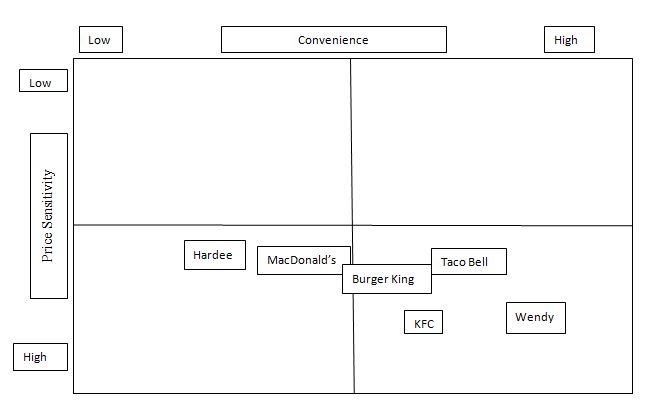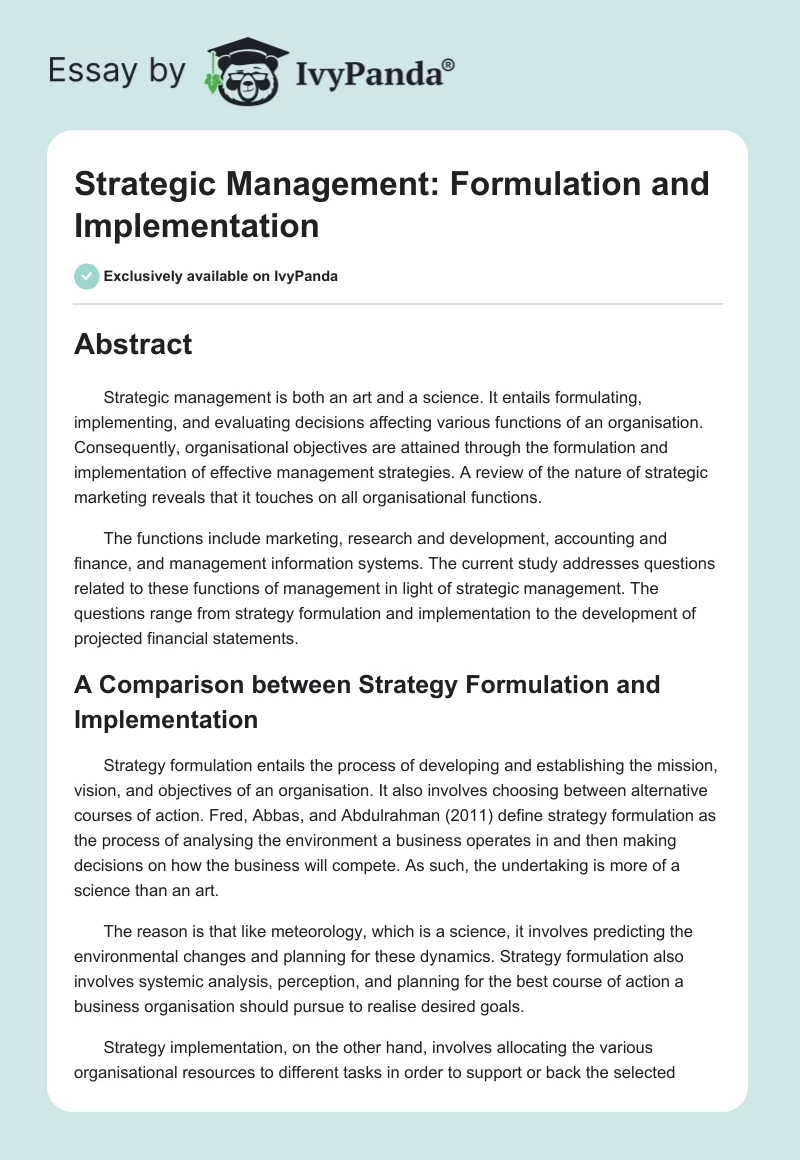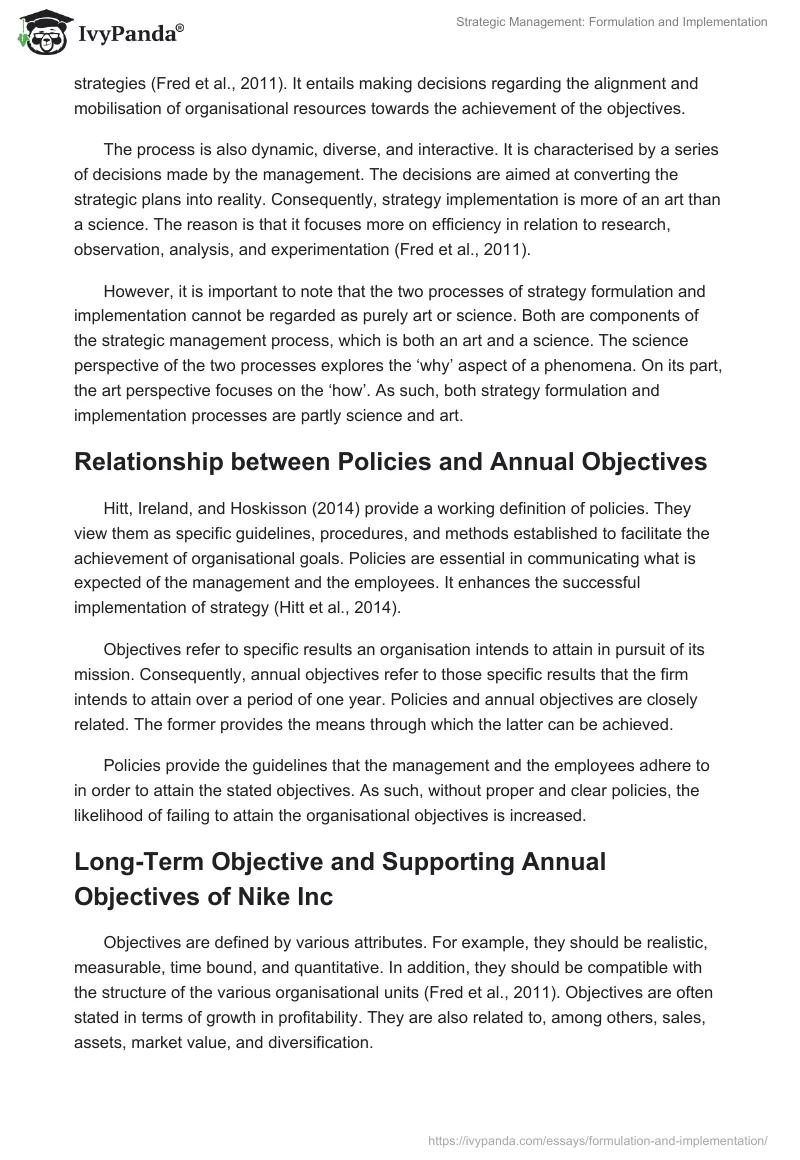Abstract
Strategic management is both an art and a science. It entails formulating, implementing, and evaluating decisions affecting various functions of an organisation. Consequently, organisational objectives are attained through the formulation and implementation of effective management strategies. A review of the nature of strategic marketing reveals that it touches on all organisational functions.
The functions include marketing, research and development, accounting and finance, and management information systems. The current study addresses questions related to these functions of management in light of strategic management. The questions range from strategy formulation and implementation to the development of projected financial statements.
A Comparison between Strategy Formulation and Implementation
Strategy formulation entails the process of developing and establishing the mission, vision, and objectives of an organisation. It also involves choosing between alternative courses of action. Fred, Abbas, and Abdulrahman (2011) define strategy formulation as the process of analysing the environment a business operates in and then making decisions on how the business will compete. As such, the undertaking is more of a science than an art.
The reason is that like meteorology, which is a science, it involves predicting the environmental changes and planning for these dynamics. Strategy formulation also involves systemic analysis, perception, and planning for the best course of action a business organisation should pursue to realise desired goals.
Strategy implementation, on the other hand, involves allocating the various organisational resources to different tasks in order to support or back the selected strategies (Fred et al., 2011). It entails making decisions regarding the alignment and mobilisation of organisational resources towards the achievement of the objectives.
The process is also dynamic, diverse, and interactive. It is characterised by a series of decisions made by the management. The decisions are aimed at converting the strategic plans into reality. Consequently, strategy implementation is more of an art than a science. The reason is that it focuses more on efficiency in relation to research, observation, analysis, and experimentation (Fred et al., 2011).
However, it is important to note that the two processes of strategy formulation and implementation cannot be regarded as purely art or science. Both are components of the strategic management process, which is both an art and a science. The science perspective of the two processes explores the ‘why’ aspect of a phenomena. On its part, the art perspective focuses on the ‘how’. As such, both strategy formulation and implementation processes are partly science and art.
Relationship between Policies and Annual Objectives
Hitt, Ireland, and Hoskisson (2014) provide a working definition of policies. They view them as specific guidelines, procedures, and methods established to facilitate the achievement of organisational goals. Policies are essential in communicating what is expected of the management and the employees. It enhances the successful implementation of strategy (Hitt et al., 2014).
Objectives refer to specific results an organisation intends to attain in pursuit of its mission. Consequently, annual objectives refer to those specific results that the firm intends to attain over a period of one year. Policies and annual objectives are closely related. The former provides the means through which the latter can be achieved.
Policies provide the guidelines that the management and the employees adhere to in order to attain the stated objectives. As such, without proper and clear policies, the likelihood of failing to attain the organisational objectives is increased.
Long-Term Objective and Supporting Annual Objectives of Nike Inc
Objectives are defined by various attributes. For example, they should be realistic, measurable, time bound, and quantitative. In addition, they should be compatible with the structure of the various organisational units (Fred et al., 2011). Objectives are often stated in terms of growth in profitability. They are also related to, among others, sales, assets, market value, and diversification.
The current long-term objective of Nike Inc. involves the achievement of sustainable and long-term growth across its portfolio of businesses and brands (Nike Inc., 2014). The supporting annual objectives include target revenue of $27 billion for the fiscal year ending 2015. In addition, the organisation plans to generate more than $12 billion of cumulative free cash flows. The revenue will come from its operations in 2015 (Nike Inc., 2014).
Policies Applying to Nike’s Present Business Policy Class
Nike Inc. maintains various policies that guide the management and employees towards realisation of long-term and annual objectives. Some of them include the promotion of fair, free, and sustainable trade. They entail enhancement of free trade and improvement of existing global, regional, bilateral, and multilateral agreements. A company can pursue this policy by seeking for new and innovative agreements, which challenge protectionism (Fred et al., 2011).
Nike Inc. also promotes intellectual property policies. Such frameworks support innovation, as well as the development of consumer trust (Nike Inc., 2014). A global company can pursue this policy by partnering with international and local public authorities in supporting modern and robust regulatory frameworks. The frameworks fight counterfeiting and promote balanced systems. It protects the organisation’s innovative products and designs.
Nike Inc. supports the policy of access to sport (Nike Inc., 2014). The agenda entails promoting access to sports and other physical activities in the various locations a company operates from. The policy is perpetuated by partnering with governments to promote sports in schools and places where games are held. Consequently, by pursuing these and other policies, companies create more opportunities for realisation of its objectives.
Reasons why Conflicts Occur During Objective Setting
Conflicts are the disagreements arising between two or more parties as a result of unresolved issues between them (Fred et al., 2011). They are a major occurrence during objective setting in business organisations. Some of the reasons why conflicts arise during this process include competition for limited resources.
Objective setting entails allocating resources, such as money, time, and labour, to specific activities. The resources are limited, while objectives are many. As a result, issues arise regarding the amount and level of assets to be allocated towards a particular goal. The interdependency between objectives also brings about conflicts during formulation. For instance, prioritising some goals over others can bring about disagreements between the various stakeholders.
Market Segmentation for Battery-Powered Lawn Mowers in Relation to the Implementation of Market Penetration Strategies
Segmentation entails dividing a broad and extensive market into several consumer subsets (Hitt et al., 2014). The consumer segments focus on the various needs and priorities of the stakeholders. Strategies are then developed and executed to achieve them. Market can be segmented on the basis of various factors. Such elements include demography, geography, behaviour, and culture.
Implementing a market penetration strategy through segmentation for the battery–powered lawn mower should be based on multiple variable subdivision approach. Any market can be both geographically and psycho-graphically segmented. On the basis of geography, the market is subdivided into regions and neighbourhoods with the highest likelihood of using the product.
Psycho-graphically, it is segmented on the basis of target customers’ lifestyles (Hitt et al., 2014). The ideal segments on the basis of the proposed approaches would include suburbs and other residential areas occupied by middle income residents. Target customers in this segment are more likely to afford and find use for the battery powered lawn mowers compared to consumers from other areas.
Product Positioning Map
Positioning of products focuses on the decision and choice of consumer group whose needs and wants are to be met by the organisation (Saloner, Shapard & Podolny, 2001). The following product positioning map positions six fast food restaurants namely Wendy’s, Burger King, McDonald’s, KFC, Hardee’s, and Taco Bell. The restaurants are positioned on the basis of price sensitivity and convenience.

The majority of the fast food restaurants position their products on the basis of price sensitivity, as how convenient they are for customers. Consequently, the prime target customers by these fast fod restaurants are mainly the middle class, and sometimes the lower upper class. The fast fod reatsurants are pursuing modest to high convenience, coupled with modest prices for their products as well.
How Marketing, Accounting and Finance, Research and Development, and Management Information Systems Managers’ Involvement in Policy Formulation Enhances Strategy Implementation
Successful implemnetation of strategies in an organisations relies to a large extent on the input of marketing, finance and accounting, R&D, and MIS managers’ while formulating strategies. Apparently, all these managers are involved in strategy implementation. Consequently, it is essential for these managers to be involved in th process of formulating the strategies they help implement (Saloner et al., 2001).
During strategy formulation, the organisation’s mission and objectives are established, as well as the decision on the best course of action for attaining the set goals. The input of marketing managers is essential during strategy formulation since they address the various issues in their department (Saloner et al., 2001). For instance, marketing managers help in establishing the best channles of marketing the organisation’s products and services.
R&D managers on the other hand offer the best and innovative input during strategy formulation on how customer needs can be met satisfactorily and at lesser cost. Accounting and Finance managers give their contribuitions on the best approaches for minimising costs and maximising returns during strategy implemntation.
Information systems managers contribution ensures that information flow between the various orgnaisational entities is done effectively and efficiently (Fred et al., 2011). Consequently, strategy implementation cordination is maintained.
Marketing, R&D, Finance and Marketing, and MIS Activities a Small Restaurant Chain can Undertake to Expand
A wide range of activities an expanding business should engage in during expansion exist. In terms of marketing, the restaurant would require first of all to decide on the target market through segmentation and products positioning. In addition, the restaurant management should develop a comprehensive marketing plan. The plan should highlight a marketing campagn featuring advertising, promotions or offers and channles for this purpose (Saloner et al., 2001).
In relation to finance and accounting, the restaurant management should decide on the source of capital for expansion, for instance a bank loan. In addition, accouting and finance managers should develop the best finanical plan. The plan should incorporate the type of expansion, for instance a franchise. A budget should also be developed to highlight expenses for the expansion, as well as expected returns. The restaurant would also require development of an efcetive and efficient management information system (Hitt et al., 2014).
The system would entail developig frameworks for communicating with customers, and other external stakeholders. In addition, frameworks for coordinating information flow and coordination of operations within the organisation require development.
Research and development activities the restaurant expansion project would require include developing products specifically targeted for the particular customers (Hitt et al., 2014). For instance, the R&D depertment will have to develop new recipes which concur with the preferences, or even culture of the target customers.
Steps to Develop Projected Financial Statements
Projected financial statements provide with the foreview of the expected results iin relation to fiinances, resulting from implementation of the organisational strategies. The statements provide summary of several projections of revenues as well as expenses for the entire budget period There are essentialy six steps in the development of projected financial statement (Hitt et al., 2014).
The first step in projected financial statements development entails preparation of income statement, without necessarily having the balance sheet. Income statement should capture the profits performance. The income statement should also demonstrate the immediate capabillity of the business to service debts, as well as real returns for grwoth in relation to the venture capital (Saloner et al., 2001).
The second step involves using the method of percentage sales in projection of costs of goods sold, as well as the expenses. These components are also reflected in the income statement. The projected net income should be calculated from the stated income statement (Fred et al., 2011). After determinig the net income, dividends for that particular year are also deducted therein.
The fifth step involves projection of a balance sheet. The balance sheet components to be projected include retained earnings, stakeholders’ equity, and current, long-term and total liabilities (Hitt et al., 2014). Other components of the balance sheet projected should be fixed, current and total projected assets. Significant changes in the projected financial statements from prior years to the projected one often arise. Such changes should be noted.
References
Fred, D., Abbas, J., & Abdulrahman, A. (2011). Strategic management: Concepts and cases. Upper Saddle River, New Jersey: Pearson Education Publishers.
Hitt, M., Ireland, D., & Hoskisson, R. (2014). Strategic management: Concepts and cases: Competitiveness and globalization (11th ed.). Boston, Massachusetts: Cengage Learning.
Nike Inc. (2014). NIKE, Inc. introduces 2015 global growth strategy. Web.
Saloner, G., Shapard, A., & Podolny, J. (2001). Strategic management. Hoboken, New Jersey: Wiley-Blackwell.


